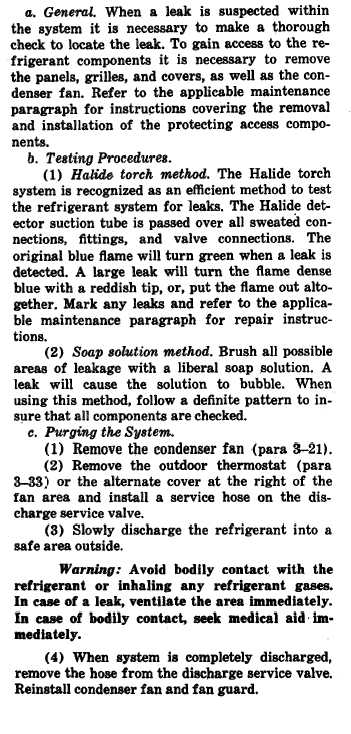|
| |
para 3-33
para 3-21
CHAPTER 6
REPAIR INSTRUCTIONS
Section I. REFRIGERATION SYSTEM
6-1. Servicing the Refrigerant System
d. Pressure Testing and Evaluating the Sys-
tem.
(1) Remove the condenser fan (para 3-21).
(2) Connect the suction line of a suitable
pressure manifold loosely to the suction service
valve. Connect the center manifold to the refri-
gerant drum and the discharge pressure gage line
to the discharge service valve. Make sure all
valves and the drum and gages are closed (fig.
6-1).
(3) Open the refrigerant drum shutoff
slightly to purge hose line. Tighten connection at
suction service valve. Open suction service valve
and drum shutoff valve.
Note. Drum must be in upright position to allow
only gaseous refrigerant to enter system.
(4) Close the drum shutoff valve when the
discharge pressure reaches 10 psig. Close suction
service valve and disconnect hose from refriger-
ant drum.
(5) Loosen suction service valve connection
and connect the center manifold line to nitrogen
drum shutoff valve (fig. 6-2).
(6) Tighten suction service valve connec-
tion, open service valve and nitrogen shutoff
valve. Build up system until pressure reaches 150
psig. Close suction service valve and shutoff
valve.
(7) Test for leaks and purge system (sub-
para b and c above).
(8) Remove the cap from discharge service
valve. Attach a suitable vacuum pump to suction
service valve and a manometer to the discharge
service valve. Open both service valves and oper-
ate the vacuum pump until the manometer indi-
cates 2.6 mm hg. abs. (millimeters mercury abso-
lute).
(9) Close suction valve and stop the pump.
Attach hose from refrigerant drum, purge air
from line with refrigerant and slowly break the
vacuum by opening the suction service valve until
760 mm hg. abs. Close suction service valve.
(10) Remove refrigerant drum and attach
vacuum pump to the suction service valve. Purge
air from hose, start pump and open suction ser-
6-1
|

